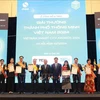Hanoi (VNA) - A group of students of the Hanoi University of Science and Technology have successfully finished their research on a 3D scanner that can measure a person’s entire body.
The research is expected to be widely applied in the medical sector and fashion industry.
Under execution since 2014 by Nguyen Dai Ma Lap Phong, Dang Huy Duong, Mai Thi Huyen Thu and Hoang Thi Nhai of the university’s Mechanical Institute, the project recently won second prize at the students’ scientific research contest.
The project received a lot of praise from several fashion companies and medical research projects, said Phong, the head of the group.
“While brainstorming about the machine, we felt a bit daring because there has been no domestic research so far on a similar type of machine. Despite this, we were determined to persuade our teachers to agree to implement the project. All of us were very surprised with the result,” Phong said.
He recalled that during research, his group recognised that the 3D scanner system was widely and effectively applied. But the price of the equipment was very high, up to 3-4 billion VN D per machine, so very few Vietnamese producers could afford it.
With assistance from the university’s qualified teachers and lecturers, after two years, Phong’s group selected suitable process to be applied for the 3D scanner, such as a control system.
The machine’s design includes an engineering system with a turntable for a person to stand on. It can turn 360 degrees at a low speed to ensure the person’s entire body is scanned.
It also includes a projector and an HD camera moving along the person’s body. Based on high-fidelity measured data, fashion designers or medical researchers can reproduce the person’s form or organs, Phong said.
Asked about the difference between his machine and an imported one, Phong said his machine uses only one camera and one projector unlike imported machines that use from three to five cameras.
“The biggest difficulty we faced was defending our idea of only using one camera before our teachers and jurymen,” Phong said.
Dr Nguyen Van Vinh of the Optics and Accurate Mechanicals Subject appreciated the group’s project, saying it has the potential to be widely applied because the global trend is towards 3D technology.
“The 3D model can be used to reproduce fashion designs for customers without the need to try on the outfit. Fashion designers can use 3D for new designs, while it can help artists reproduce art works and ancient architecture,” Vinh said.
Meanwhile, lecturer Nguyen Thi Kim Cuc, who is in charge of guiding the group, said applying 3D technology takes less time and is more accurate than applying traditional anthropometry. The product can be used to produce cartoons, graphics and in medical research.
"For example, to get the right artificial leg for an amputee, the 3D scanner can be usied to accurately measure the leg’s parameters for a suitable artificial leg," Cuc said.
Vinh said to put the machine into daily use, the group should conduct more research to improve the degree of accuracy, reduce measuring time and improve its form to be more compact for easy transport and mobile measurement.
Phong said his group hoped to optimise the machine as soon as possible to meet the increasing demand.-VNA























